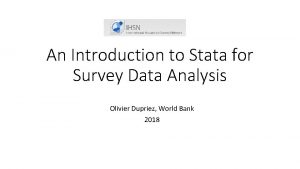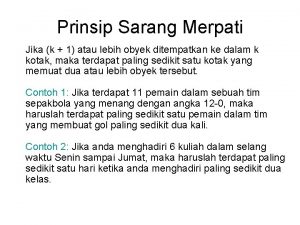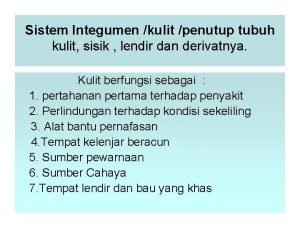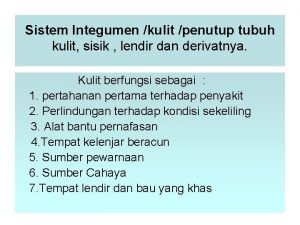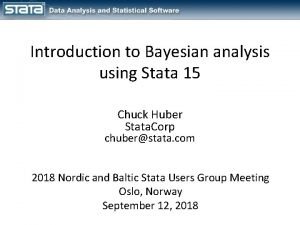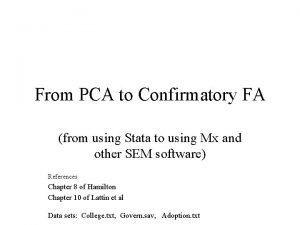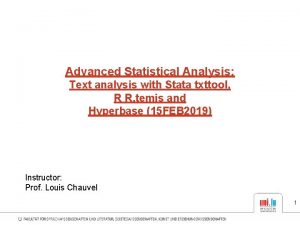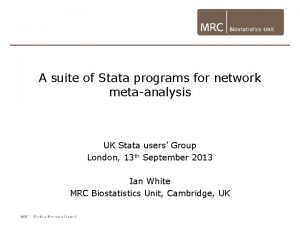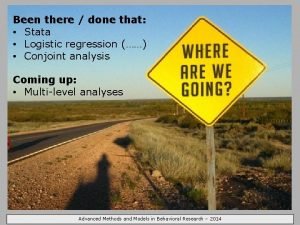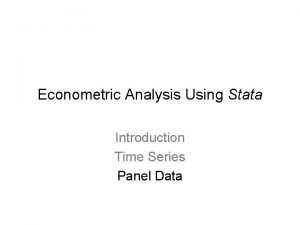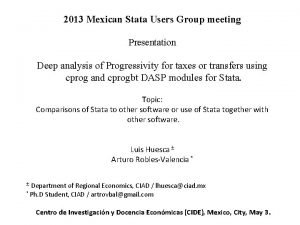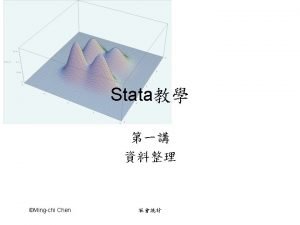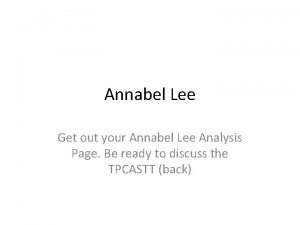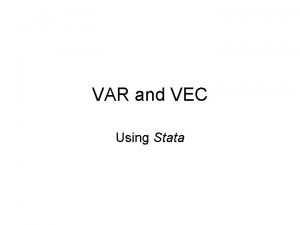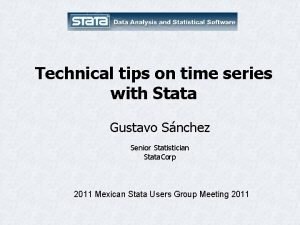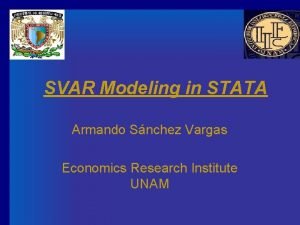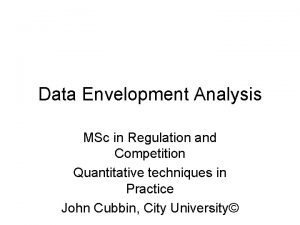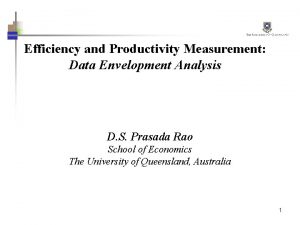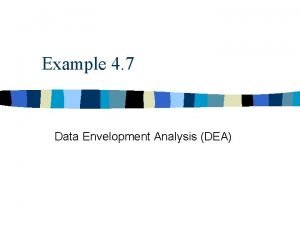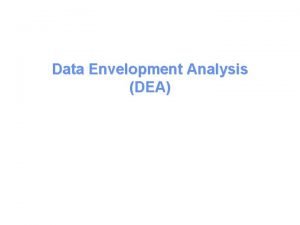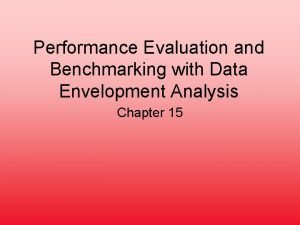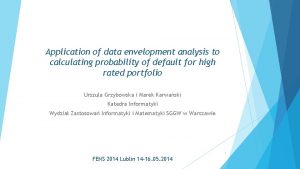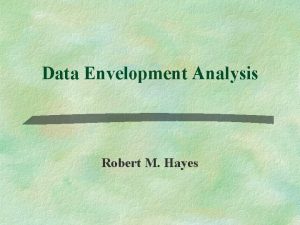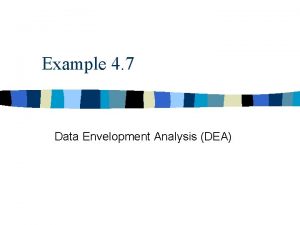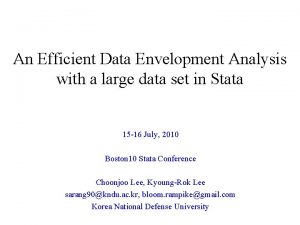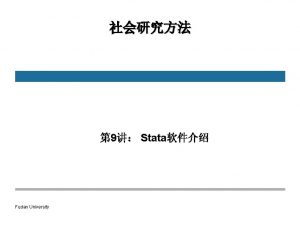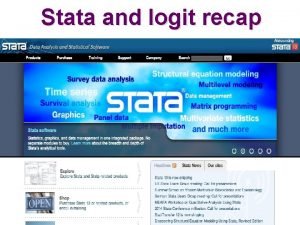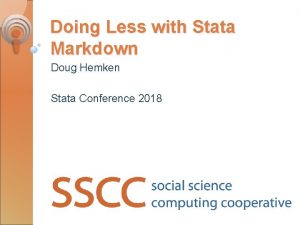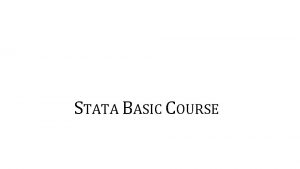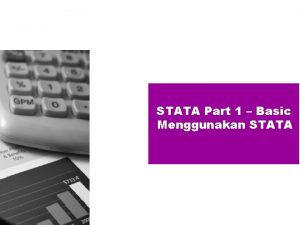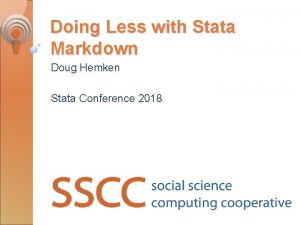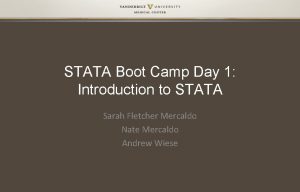Data Envelopment Analysis in Stata Choonjoo Lee sarang



























- Slides: 27

Data Envelopment Analysis in Stata Choonjoo Lee (sarang 90@kndu. ac. kr) Yong-bae Ji (jyb 7707@hanmail. net) Korea National Defense University, Republic of Korea Stata Conference DC 09 (July 30 -31, 2009) DEA in Stata®

Outline 1. Why DEA in Stata? 2. The Basics of DEA 3. The Stata/DEA program 4. Stata/DEA Examples 5. DEA Frontiers in Stata? 6. References DEA in Stata®

1. Why DEA in Stata? ¢ Software Tools for Frontier Analysis Method Data Envelopment Analysis Stochastic Frontier Analysis Language AMPL, GAMS, Mathematica, SAS, VBA Matlab, R Program DEA Excel Solver, DEAP(v 2. 1), DEAQual, DEA-Solver-Pro, EMS, FEAR, Frontier Analyst, On. Front, PIM-DEAsoft, Pioneer, Warwick DEA, Max. DEA, Kon. Si DEA, ISYDS(SIAD), xl. DEA, LIMDEP, Sto. NED Stata, BSFM, Frontier(v 4. 1), Win. BUGS, LIMDEP, Sto. NED DEA Solver Online, i. DEA . Online Program DEA in Stata®

1. Why DEA in Stata? (cont. ) ¢ DEA literatures by Year(2001 -2009) ☞ D/B: Science Direct, EBSCO, Google scholar, *SCI, SSCI Query: DEA or Data Envelopment Analysis in title, key word, abstract more to go DEA in Stata®

1. Why DEA in Stata? (cont. ) ¢ DEA literatures by Journal(2001 -2009) Source Title Record Count % of 446 European J. of Oper. Res. 93 20. 8 J. of the Oper. Res. Society 37 8. 3 App. Math. and Computation 36 8. 1 J. of Prod. Ana. 30 6. 7 Omega-Int. of Management Sci. 21 4. 7 Comp. & Oper. Research 15 3. 3 Expert Systems with Applications 13 2. 9 Annal of Oper. Res. 10 2. 2 App. Economics 10 2. 2 Int. J. of Infor. Tech. & Decision Making 10 2. 2 DEA in Stata®

1. Why DEA in Stata? (cont. ) ¢ DEA literatures by Subject(2001 -2009) DEA in Stata®

1. Why DEA in Stata? (cont. ) … Stata is easy to use and powerful statistical software; Data Envelopment Analysis code in Stata will promote the efficiency in data management for DEA users and open new application areas in statistical inference for Stata users. DEA in Stata®

2. The Basics of DEA(cont. ) ¢ DEA Concept Outputs Performance(Efficiency, Productivity) = Inputs equipment space # type A labor Outputs Technology + Decision Making # type B labor ………………. ? #type A customer #type B customer quality index oper. profit ………………. DEA in Stata®

2. The Basics of DEA(cont. ) ¢ Assumptions to analyze the black box l Economic Behaviors: No input, no output! l (Free) Disposability l Convexity l Frontier Search: Piece-wise Linear Method l Scale Economy l Orientation: Input-based or Output-based Analysis l… ¢ Interpretation of DEA Results l X-inefficiency l Rational Choice of Input-Output Mixes l Performance l… DEA in Stata®

2. The Basics of DEA(cont. ) ¢ Terms & Notations l : Input, output matrix l : Row vector l l : Non-negativity vector : Real variable l Decision Making Units(DMUs) DEA in Stata®

2. The Basics of DEA(cont. ) ¢ Basic DEA Models: CCR, BCC Orientation Primal Dual Input Oriented Output Oriented ( )* is the additional constraint in BCC model DEA in Stata®

2. The Basics of DEA(cont. ) ¢ Characteristics of DEA l No assumption about Input-Output Function l No limits to the number of inputs and outputs l Not required to weight restrictions l Provide reference sets for benchmarking l Provide useful information for input-output mix decision l n times computations for n DMUs DEA in Stata®

3. The Stata/DEA program ¢ User Written Stata/DEA Description l Considered the basic DEA models (CCR & BCC) l Can handle both input minimization and output maximization problems l The data flow in the Stata/DEA program ¡ the input and output variables data sets required ¡ the DEA options define the model ¡ the “Stata/DEA” program consists of “basic” and “lp” subroutine ¡ the result data sets available for print or further analysis DEA in Stata®

3. The Stata/DEA program(cont. ) ¢ Diagram of Data flow in Stata/DEA program DEA in Stata®

3. The Stata/DEA program(cont. ) ¢ Stata/DEA Syntax (program code under Stata journal review) • dea [, data(string) iotype(string) model(string) lambda] DEA in Stata®

4. Stata/DEA Examples ¢ Example 1: Store’s efficiency case(for model verification) l Data: two inputs, two outputs, and 5 DMUs ※ Data imported from Cooper et al. (2006), p. 75, Table 3. 7 l The inputs are ¡ The number of employees (Employee) ¡ The floor area (Area) l The outputs are ¡ The volume of sales (Sales) ¡ The volume of profits (Profits) DEA in Stata®

4. Stata/DEA Examples(cont. ) l The data file including input and output variables ※ The input and output variables are saved in files "ta 3_7. csv" l A user needs to set the options as required and run the following code for input orientation model • dea, data(ta 3_7) iotype(input) model(ccr) lambda DEA in Stata®

4. Stata/DEA Examples(cont. ) ¢ The Result Window DEA in Stata®

4. Stata/DEA Examples(cont. ) l The result file including the efficiency score and reference set ☞ Scores match with the results of Cooper et. al. (2006). DEA in Stata®

4. Stata/DEA Examples(cont. ) l The result file including detail values for the efficiency score and reference set (lambda option) DEA in Stata®

4. Stata/DEA Examples(cont. ) ¢ Example 2: Weapons system construction efficiency l two inputs, three outputs, and 10 DMUs ※ Data from JAA fr( Jane's Armour and Artillery) l The inputs are ¡ Combat weight ¡ Height l The outputs are ¡ Power-to-weight ratio ¡ Max road speed ¡ Main armament diameter DEA in Stata®

4. Stata/DEA Examples(cont. ) l The data file including input and output variables ※ The input and output variables are saved in files "t 4_2. csv" DEA in Stata®

4. Stata/DEA Examples(cont. ) • dea, data(t 4_2) iotype(output) model(ccr) lambda DEA in Stata®

4. Stata/DEA Examples(cont. ) l The result file including the efficiency score and reference set DEA in Stata®

4. Stata/DEA Examples(cont. ) l The result file including detail values for the efficiency score and reference set (lambda option) DEA in Stata®

5. DEA Frontiers in Stata? ¢ The Stata/DEA program is a new application in Stata. ¢ DEA is a prevalent and powerful managerial tool for measuring the performance. ¢ The Stata/DEA program will provide Stata users with several opportunities : l No extra cost to access DEA l Flexible DEA model extension and development l A powerful managerial tool as well as data management, statistical analysis, and optimization procedures ¢ The Stata/DEA program report's files can directly feed to other Stata routines for further analysis. ¢ Further Extensions to 2 nd Stage Regression Analysis, DGP of DEA, Statistical Inferences of DEA, Case Specific DEA Models, and more are possible. DEA in Stata®

6. References ¢ Lee, C. , & Ji, Y. (2009). “Data Envelopment Analysis in Stata”, under review by the Stata Journal. ¢ Cooper, W. W. , Seiford, L. M. , & Tone, A. (2006). Introduction to Data Envelopment Analysis and Its Uses, Springer Science+Business Media. ¢ Charnes, A. , Cooper, W. W. , & Rhodes, E. (1981). "Evaluating Program and Managerial Efficiency: An Application of Data Envelopment Analysis to Program Follow Through. " Management Science, Vol. 27. , pp. 668 -697. ¢ Banker, R. D. , Charnes, A. , & Coopers, A. A. (1984). “Some Models for Estimating Technical and Scale Inefficiencies in Data Envelopment Analysis”, Management Science Vol. 30, No. 9, pp. 1078 -1092. DEA in Stata®
 Confusion matrix stata
Confusion matrix stata Model piramida
Model piramida Amit nanavati md
Amit nanavati md Contoh soal sarang merpati
Contoh soal sarang merpati Contoh ikan sisik ganoid
Contoh ikan sisik ganoid Contoh ikan sisik placoid
Contoh ikan sisik placoid International mindedness in mathematics
International mindedness in mathematics Chuck huber stata
Chuck huber stata Bayesian analysis with stata
Bayesian analysis with stata Rmmss
Rmmss Txttool
Txttool Stata network meta-analysis
Stata network meta-analysis Stata conjoint analysis
Stata conjoint analysis Time series analysis using stata
Time series analysis using stata Distributive analysis stata package
Distributive analysis stata package Correspondence analysis stata
Correspondence analysis stata Data cleaning stata
Data cleaning stata Stata infix
Stata infix Unbalanced panel data stata
Unbalanced panel data stata Tpcastt annabel lee
Tpcastt annabel lee Data quality is always a concern with secondary data
Data quality is always a concern with secondary data Procedures of data collection
Procedures of data collection Data preparation and basic data analysis
Data preparation and basic data analysis Data acquisition and data analysis
Data acquisition and data analysis Raymie stata
Raymie stata Var model
Var model Kalman filter stata
Kalman filter stata Stata svar
Stata svar
